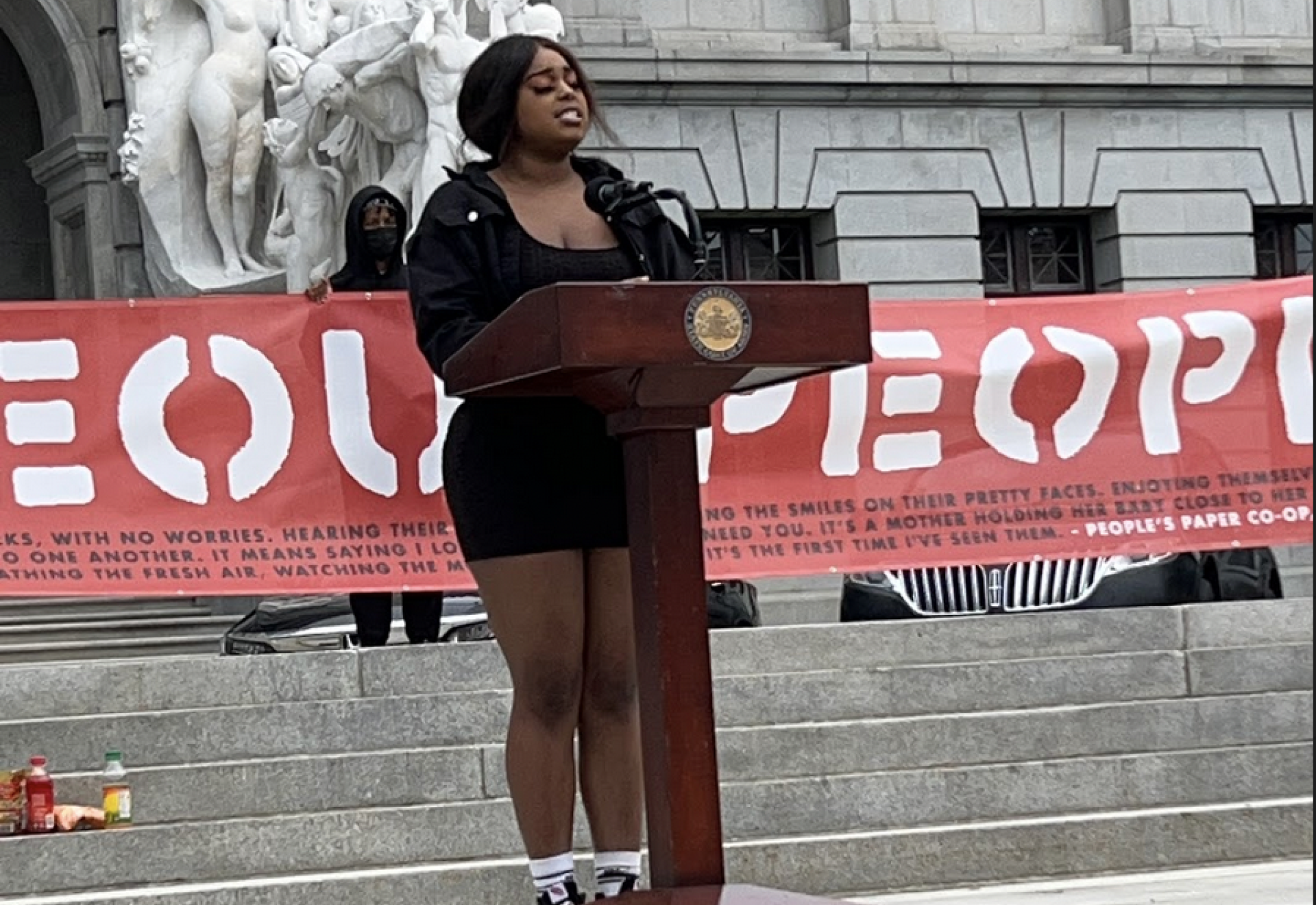Leading With Youth In Advocacy
The strategies discussed in this chapter capture both the importance of youth leadership when selecting advocacy work and the importance of field knowledge and community collaboration when selecting advocacy work.

Picking an issue to build a campaign around must be an inclusive process. A successful campaign must include feedback from the young leaders in your program, other young leaders outside of the program, collaboration with internal staff and their projects, input from professionals in the field, movement around that issue at the local, state, or national level, and a viable solution to the issue.
Building a successful campaign requires buy-in from both allies and decision-makers.
Program staff are tasked with the responsibility of building and sustaining partnerships with similar grass-roots organizations and government bodies to help advance the campaign and then implement the policy changes. Additionally, collaboration with like-minded and supportive groups provides young members a sense of community and inclusion with advocacy efforts beyond the walls of your organization.
GUIDING PRINCIPLES
Creating a space for young people to lead policy change efforts in their community can allow for long lasting solutions and systemic change.
Young people have the desire to change their community and many ideas about how to change them. Engaging young people in the process of developing campaigns is vital to identifying social problems, the root causes of those problems, and solutions for long-standing system change.
Sustainable system changes can only happen when young advocates are actually included in the policy change process.

IMPORTANT TAKEAWAYS
The very first part of this process happens when young people are included in the selection of the issue they will campaign around and ensure that youth advocates are making an informed decision about the topic that they select. Another element to consider around developing a campaign is how to connect both the youth advocates and the local community to the issue.
Allow Youth to Guide the Selection of Issue Areas
Select an Advocacy Topic Based on a Mutual Understanding of the Problem
Build a Personal Connection to the Issue
Guiding Principles Continued
Establishing and sustaining partnerships to advance a program or a project must be at the forefront of the campaign. The process of collaboration can seem daunting or may not be prioritized due to capacity restrictions in nonprofit organizations. However, collaboration, though time intensive, is worthwhile since policy changes become infinitely more possible when organizations and partners are working together to support its success.
Persuading key decision-makers to support and advance the policy change your campaign outlines is essential to the success of the project and to having the youth advocates feel a sense of accomplishment.
Gaining the respect and buy-in of policymakers who are able to impact change at the root of the problem that the youth-led group is trying to address will help ensure that change is systematically implemented.
IMPORTANT TAKEAWAYS
Prioritize Networking with other Youth-led Programs
Partner with Key Stakeholders to Encourage Solution Buy-in
OUR APPROACH
In this section, we’ll discuss identifying policy windows, recognizing root causes, collaborating with opposing and like-minded partners, preparing outside partners, and working with media partners.
Identifying Policy Windows
Juvenile Law Center’s Youth Advocacy Program campaigns follow a project calendar that runs from October to May. New campaigns are chosen each year by the youth advocates with the support of staff. In recent years, the program staff members at Juvenile Law Center have incorporated more opportunities to teach the youth advocates how to make informed decisions around campaign topic selection. This process is rooted in the research of John Kingdon’s “Multiple Stream Theory” and the process of policy analysis and open policy windows.
The theory goes that if advocates identify a problem with enough people impacted, a viable policy solution, and sufficient political support to advance the solution, a window of opportunity opens where public policy can be introduced and implemented.
Previously, program staff supported youth advocates in identifying issues based solely on personal experience and passion. Unfortunately, many of the projects that were chosen based on these standards only had momentum in the beginning of the campaign but fizzled without a clear policy solution or strong political support, leaving youth advocates disappointed in the process. Since revising the decision-making process based on lessons learned, the youth-led campaigns have reached new levels of success and sustainability because the groups saw implementation of their projects, and partners were identified to carry on the work.
Recognizing Root Causes
The Youth Advocacy Program staff has taken a more deliberate approach to issue selection and campaign development over the years to ensure that the youth advocates have the space to also address root issues of systemic racism in their projects. The juvenile justice system and foster care system disproportionately impact Black, Latinx/Latine, and Indigenous young people and other young people of color.
If advocacy efforts do not include discussions of race and how a young person’s race has an impact on their access to resources and opportunities, then any effort to implement long lasting systemic change will come up short.
Youth Advocacy staff do not shy away from deliberately calling out race, oppression, and privilege during weekly workshops.
Collaborating with Opposing and Like-minded Partners
The Youth Advocacy Program at Juvenile Law Center has a long history and intention of collaborating with funders, community partners, and key decision-makers. The youth advocates meet regularly with key decision makers in Philadelphia, Pennsylvania, and nationally. They not only appreciate the youth advocates’ willingness to speak about their sometimes-traumatizing experiences in the juvenile justice and foster care systems, they also are challenged by the thoughtful campaigns and recommendations for change that the young people have worked diligently to develop. Equally important, programs need to establish relationships with grassroots, youth-led organizations, movements, and projects. These relationships are crucial to the program, and youth advocates in their advocacy campaign by having support and guidance from others in the city.
Preparing Outside Partners
All interactions with outside partners take a great deal of preparation from program staff to ensure that youth advocates can clearly and confidently convey their message to their audience.
If youth advocates present to a group of decision makers who have had a major impact on their own lives (judges, probation officers, case workers, etc), they need to feel that their anger and fear is validated by program staff, and they need to know they will be supported during this experience.
Additionally, program staff need to communicate these concerns to the partner and request that they follow guidelines about asking questions and allowing the youth speaker to decline questions.
Working with Media Partners
The Youth Advocacy Program also partners with various media outlets to share recommendations, lived experiences, and project campaigns. These partnerships are tricky to navigate. Media outlets often want as much detail as possible for their stories.
Youth Advocacy Program staff have protocols that state that youth advocates should never feel they have to talk about a part of their story that they are uncomfortable sharing and they can share whatever form of their name that makes them most comfortable.
These protocols also cover informing youth advocates of the possible implications of sharing photos and first and last names publicly. Program management works closely with communications staff at Juvenile Law Center to ensure that every media opportunity has the young person’s best interest in mind, images and names are used with consent, and the young person knows they always have the freedom to decline or step away from an interview.

DOWNLOADABLE RESOURCE
YOUTH ADVOCATE REFLECTIONS
When asked about the development of their campaigns, the group was particularly excited about the project from the 2018-2019-year Operation: Education.
This policy project marked the first time in the history of the Youth Advocacy Program that both Youth Fostering Change and Juveniles for Justice collaborated on a single issue.
The youth advocates chose to focus on education because it is a relevant issue for every young person. They also recognized that there was a policy window for this issue because of the free tuition for foster youth bill that was on the horizon in Pennsylvania. The program provided youth with the knowledge they needed regarding policy windows so that they could make an informed decision about which issues were best for their project focus. Learning about policy windows prompted them to consider: Which topic will go further? Which issue can wait? Which issue cannot wait? Youth advocates think it is important to have all relevant background information for potential policy projects before they make a choice. They were able to come to a consensus on this topic because an environment of non-judgement was established in the workshops by the program managers which allowed everyone to share their own perspectives.
When the youth advocates were asked about working with external partners, they recognized the necessity of collaborating with community partners in order to increase the support and overall effectiveness of policy projects. The youth advocates discussed the many different partners they collaborated with for the “Broken Bridges” project (Juveniles for Justice’s 2017- 2018 campaign and publication to address harsh, harmful practices the youth advocates experienced in juvenile placement facilities). To garner support they met attorneys, judges, Councilmember Helen Gym from the city of Philadelphia, and testified at City Hall. To acquire feedback from other young people about their experience in institutional placements, they sought the input of youth with experience in the foster care system who were involved with the local Philadelphia group Youth Healers, and other youth groups throughout Philadelphia.